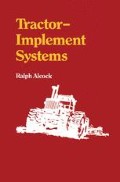Abstract
Soils, like metals, can behave both elastically and plastically. Elastic deformation refers to the ability of the deformed material to return to its original dimensions. Plastic deformation refers to a condition of permanent deformation. For a soil in the elastic condition, a given applied force causes a known deformation. On removal of the force, recovery takes place.
Access this chapter
Tax calculation will be finalised at checkout
Purchases are for personal use only
Preview
Unable to display preview. Download preview PDF.
References
Alcock, R. (1983). Battery powered vehicles for field work. Trans. ASAE 26(1), 10–13.
ASAE (1982). Soil cone penetrometer. ASAE Standard S.313. Am. Soc. Agric. Engr.
Bekker, M. G. (1956). “Theory of Land Locomotion.” Univ. of Michigan Press, Ann Arbor.
Bekker, M. G. (1960). “Off-the-Road Locomotion.” Univ. of Michigan Press, Ann Arbor.
Bekker, M. G. (1969). “Introduction to Terrain Vehicle Systems.” Univ. of Michigan Press, Ann Arbor.
Gee-Clough, D., McAllister, M., Pearson, G., and Evernden, D. W. (1978). The empirical prediction of tractor-implement field performance. J. Terramech. 15(2), 81–94.
Micklethwaite, E. W. E. (1944). Soil mechanics in relation to fighting vehicles. Military College of Science, Chertsey, England.
Reece, A. R. (1966). Principles of soil-vehicle mechanics. Proc. Inst. Mech. Engr. 180, Part 2A(2), 45–66.
Uffelmann, F. L. (1961). The performance of rigid cylindrical wheels on clay soil. Proc. 1st Int. Conf. Mechanics of Soil-Vehicle Systems, Turin.
Voorhees, M. L., and Walker, P. N. (1977). Tractionability as a function of soil moisture. Trans. ASAE 20(5), 806–809.
Wismer, R. D. (1982). Soil dynamics: A review of theory and applications. SAE paper no. 820656. SAE, Warrendale, PA.
Wismer, R. D., and Luth, H. J. (1974). Off-road traction prediction for wheeled vehicles. Trans. ASAE 17(1), 8–10, 14.
Author information
Authors and Affiliations
Rights and permissions
Copyright information
© 1986 The AVI Publishing Company, Inc.
About this chapter
Cite this chapter
Alcock, R. (1986). Traction. In: Tractor-Implement Systems. Springer, Boston, MA. https://doi.org/10.1007/978-1-4684-6879-3_4
Download citation
DOI: https://doi.org/10.1007/978-1-4684-6879-3_4
Publisher Name: Springer, Boston, MA
Print ISBN: 978-1-4684-6881-6
Online ISBN: 978-1-4684-6879-3
eBook Packages: Springer Book Archive

